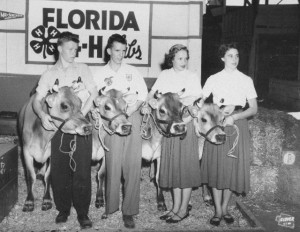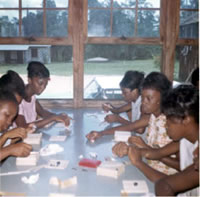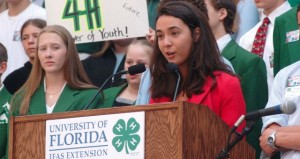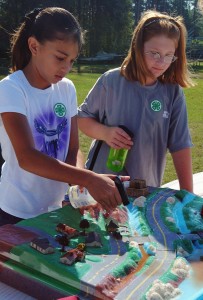1920s-1960s
4-H continued to grow in Florida throughout the 20th century, developing many of the features commonly associated with the 4-H clover. School club programs were conducted by agricultural Extension agents teaching projects in agronomy, horticulture, animal husbandry and home economics. At county fairs, 4-H’ers brought their prize pigs, cows, chickens and other animals to judging contests, and set up displays about clothing repair, canning and forestry. Permanent 4-H camps were set up for summer swimming classes and campfires, beginning with Camp Timpoochee in 1926. And every year, 4-H’ers boarded buses and trains to travel to state and national conferences. These are all activities that 4-H members enjoy to this day, but beginning in the early 1960s, a number of systemic changes occurred that helped to make 4-H into a broader, more inclusive organization.

Source: Smathers Archives
Finally Getting Together
For its first fifty years, there were really three separate 4-H programs in Florida: one for white boys, one for white girls, and one for African-American youth. Each program had its own governing council and its own headquarters—the University of Florida for the 4-H boys’ clubs, Florida State University for 4-H girls, and Florida A & M University for African-American 4-H clubs. Camps and conferences could sometimes be co-educational, but were racially segregated, with African-American 4-H’ers having a separate residential camp at Doe Lake in the Ocala National Forest.

Source: Florida 4-H photo archives.
This system began to change in 1964. In that year, the first 4-H Club Congress was held on the University of Florida campus; at the congress it was decided that the separate Girls and Boys councils would be merged into a single entity and Florida 4-H events would become fully co-educational.
Nineteen sixty-four also marked passage of the Civil Rights Act, which prohibited discrimination on the basis of race, color or national origin for all federally assisted programs, including 4-H. At the Florida 4-H Club Congress in 1966, African-American youth attended a state conference with white youth for the first time. Thereafter, the 4-H staffs from Florida A & M, Florida State and UF were merged into a single 4-H program to serve all Florida’s youth.
Transitions and Foundations
While the integration of 4-H was relatively smooth at the state leadership level, many local school districts resisted it for a number of years. Moreover, as Florida’s urban population grew, 4-H had begun broadening its curriculum beyond its rural scope, offering courses in electronics, public speaking and personal finance. As a result of these changes, 4-H began moving its clubs out of public schools and into community-based programs. Volunteer club leaders were recruited from the community to teach and mentor 4-H youth, and state Extension faculty spent much of the late 1960s training and managing volunteers in 4-H ‘learn-by-doing’ educational methods. Between 1964 and 1984, the number of 4-H volunteers grew to about 10,400 teens and adults.
The Florida 4-H Foundation was also established at this time to recruit private donors to help support 4-H. Since 1963, funds contributed through the foundation have helped Florida 4-H members go to college and attend national conferences, have improved facilities at camps and clubs, and have supported the development of new programs that have helped 4-H thrive all these years.
The transition out of public schools caused enrollment to drop at first, but the efforts of volunteers, Extension agents and supporters soon helped 4-H enrollment grow to an all-time high of 86,000 members by 1974.
4-H Finding Its Voice
The 1970s saw 4-H making a move back into schools, and a rapid expansion of programs aimed at civic engagement. The 4-H/Tropicana Public Speaking Program, established in 1969, is designed to help young people learn the techniques of effective public speaking. One of the most successful programs has been Florida 4-H Legislature, which began in 1973 as the State 4-H Citizenship Program. In “Leg” (rhymes with “edge”), delegates from 4-H clubs around the state converge on Tallahassee each summer to form a simulated state government, where they propose bills, rule on court cases and engage in spirited debate about real-world issues.

(Photo: Thomas Wright)
In 1996, Florida 4-H merged with the University of Florida’s Department of Family, Youth and Community Sciences. This closer tie with the research and teaching facilities of the university yielded new special interest, school enrichment, and after school programs dealing with food science, nutrition, community service, computer science and robotics.
In the early 2000s, 4-H began a partnership with the U.S. Military to help families of soldiers deployed overseas. Operation Military Kids reaches over 13,000 youth every year through Family Days, Hero Packs, 4-H club meetings, special events and summer camps.
Florida 4-H Today
Today, more than 220,000 youth ages 5-18 are involved in the UF/IFAS Extension 4-H Youth Development Program, and they’re guided and supported by 19,000 adult and young adult volunteers. Today’s 4-H’ers are culturally and economically diverse, and are more likely to live in the city than in the country. 4-H projects taught in schools, camps and clubs cover every aspect of science and technology, citizenship and healthy living.
Florida 4-H might not look quite like it did in 1914, but the core of its mission remains the same—to use a learn-by-doing approach and caring adults to help youth gain the knowledge and life skills to be productive, responsible adults.

(AP photo/University of Florida/IFAS/Tara Piasio)
To find out more about Florida 4-H today, visit http://florida4h.org/
Sources:
Florida 4-H (n.d.) Florida 4-H History Timeline. Accessed December 2013 at http://florida4h.org/news/Promotional%20Kits/files/History_Timeline.pdf
Florida 4-H (n.d.) Florida 4-H Statistical Snapshot. Accessed December 2013 at http://florida4h.org/about1/impact/Statistical_Snapshot.pdf
Florida 4-H (n.d.) History of 4-H in Florida. Accessed December 2013 at http://florida4h.org/about/history/florida/
 0
0
